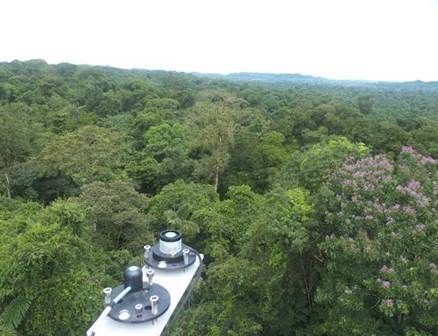GoAmazon2014/15 data are illuminating the connections between forests and atmosphere

This is a feature story published by the DOE Office of Science and shared with permission.
As he gazed down on the Amazon from above, shining leaves formed waves of foliage. The wind rippled through them, creating eddies and pools of green. From this point of view, some people may have just seen trees. But from his lofty perch, Kolby Jardine, a researcher at the U.S. Department of Energy’s (DOE) Lawrence Berkeley National Laboratory, saw more—the forest’s complex ecological cycle. Starting from emissions put out by the leaves to the clouds high above, each component influences all of the others.
Jardine was part of the DOE Office of Science’s Green Ocean Amazon (GoAmazon2014/15) field campaign, which focused on better understanding the Amazon Basin’s water cycle. The GoAmazon team took data from January 2014 to December 2015 using the DOE Atmospheric Radiation Measurement user facility.
By taking data on a swaying, narrow platform taller than a 10-story building, Jardine hoped to peer into one part of this system—how tropical leaves produce emissions.
“You really feel what it’s like to be a leaf in the upper canopy,” he said.
The Amazon is the world’s largest and most diverse tropical rainforest, stretching over nine countries. While human-made emissions pollute the air in the dry season, the air above the Amazon in the wet season is one of the cleanest places on earth.
That contrast makes it the perfect place for Jardine and other researchers to study how trees let off emissions and what effects those emissions have on climate.
Read the full feature on the DOE Office of Science website.
# # #The ARM Climate Research Facility is a DOE Office of Science user facility. The ARM Facility is operated by nine DOE national laboratories.

